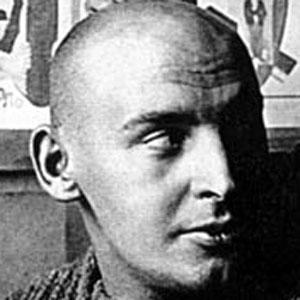Quick Facts

| Full Name | Alexander Rodchenko |
| Occupation | Sculptor |
| Date Of Birth | Dec 5, 1891(1891-12-05) |
| Age | 135 |
| Date Of Death | December 3, 1956, Moscow, Russia |
| Birthplace | Russia |
| Country | Russia |
| Horoscope | Sagittarius |
Alexander Rodchenko Biography
| Name | Alexander Rodchenko |
| Birthday | Dec 5 |
| Birth Year | 1891 |
| Place Of Birth | Russia |
| Birth Country | Russia |
| Birth Sign | Sagittarius |
| Spouse | Varvara Stepanova |
| Children(s) | Varvara Rodchenko |
Alexander Rodchenko is one of the most popular and richest Sculptor who was born on December 5, 1891 in Russia, Russia. Russian graphic designer and sculptor who established constructivism. He created “Dance. An Objectless Composition,” in 1915.
He was influenced by Salvador Dali.
He married Varvara Stepanova, who he met at the Kazan School of Art.
Alexander Rodchenko Net Worth
| Net Worth | $5 Million |
| Source Of Income | Sculptor |
| House | Living in own house. |
Alexander Rodchenko is one of the richest Sculptor from Russia. According to our analysis, Wikipedia, Forbes & Business Insider, Alexander Rodchenko 's net worth $5 Million. (Last Update: December 11, 2023)
While a child, he studied illustrations in art magazines, which inspired him to pursue art.
He painted a portrait of Lilya Brik, which was featured as cover art for the band Franz Ferdinand.
Height, Weight & Body Measurements
Alexander Rodchenko height Not available right now. Alexander weight Not Known & body measurements will update soon.
Who is Alexander Rodchenko Dating?
According to our records, Alexander Rodchenko married to Varvara Stepanova. As of December 1, 2023, Alexander Rodchenko’s is not dating anyone.
Relationships Record : We have no records of past relationships for Alexander Rodchenko. You may help us to build the dating records for Alexander Rodchenko!
Facts & Trivia
Alexander Ranked on the list of most popular Sculptor. Also ranked in the elit list of famous people born in Russia. Alexander Rodchenko celebrates birthday on December 5 of every year.
Top Facts about Alexander Rodchenko
- Pioneer of Russian Constructivism.
- Influential photographer and graphic designer.
- Co-founder of the October group.
- Designed propaganda posters for Soviet government.
- Experimented with photomontage and typography.
- Worked closely with filmmaker Sergei Eisenstein.
- Created innovative book designs and covers.
- Taught at Moscow’s VKhUTEMAS art school.
- His work influenced modern design movements worldwide.
- Died in poverty, but his legacy lives on today.
What was the constructivist movement?
Constructivism is an early twentieth-century art movement founded in 1915 by Vladimir Tatlin and Alexander Rodchenko. Abstract and austere, constructivist art aimed to reflect modern industrial society and urban space. The movement rejected decorative stylization in favor of the industrial assemblage of materials.
What techniques did Alexander Rodchenko use?
Inspired by his work in illustration and commercial designs, Rodchenko turned to photography in 1924. He wanted to incorporate his own imagery into the photomontages that he had begun working on the previous year. From that point on, photomontage became one of his favored techniques.
Who inspired Rodchenko?
Rodchenko’s art and thought moved extremely rapidly in the 1910s. He began as an aesthete, inspired by Art Nouveau artists such as Aubrey Beardsley. He later became a Futurist. He digested the work of Vladimir Tatlin, and the Suprematism of Kazimir Malevich.
What was Alexander Rodchenko most known for?
Alexander Rodchenko was a founding member of Russian Constructivism—the avant- garde movement characterized by unembellished abstraction— along with Vladimir Tatlin. He was known for his politically motivated photography, posters, paintings, and sculpture.
Was Rodchenko a constructivist?
Rodchenko was one of the most versatile constructivist and productivist artists to emerge after the Russian Revolution. He worked as a painter and graphic designer before turning to photomontage and photography. His photography was socially engaged, formally innovative, and opposed to a painterly aesthetic.